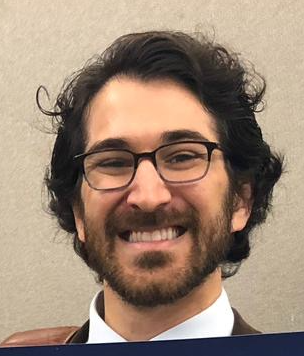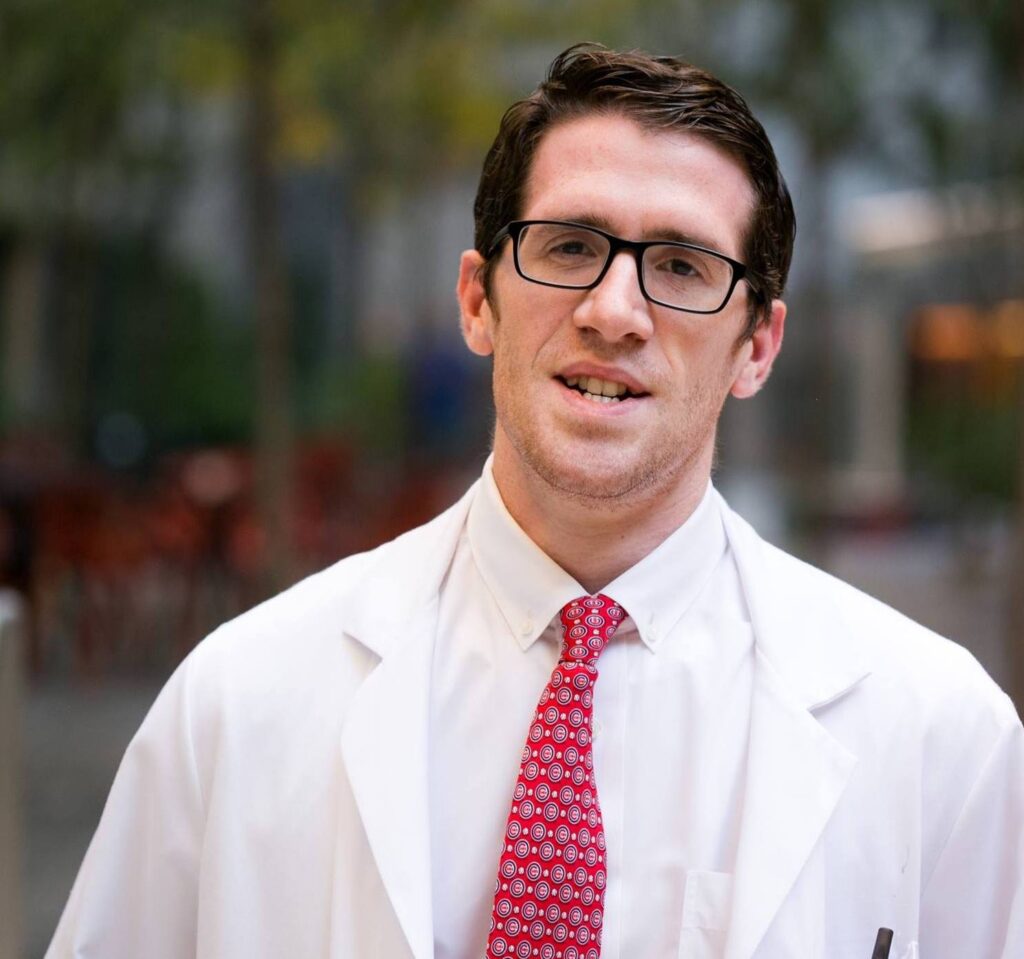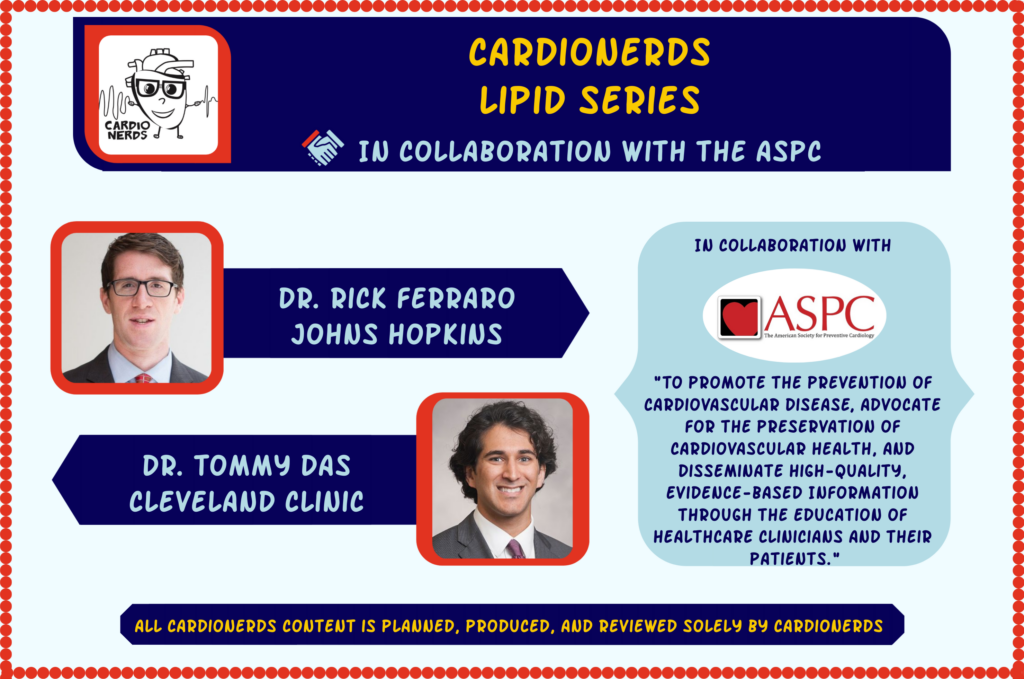
 Cardionerds: A Cardiology Podcast
Cardionerds: A Cardiology Podcast 156. Lipids: Triglycerides – Pathophysiology to Clinical Outcomes with Dr. Matthew Budoff
Origin of Interest
- Dr. Budoff's interest in cardiovascular prevention started with coronary calcium scanning.
- He was inspired by the potential to detect early heart disease and improve patient outcomes.
Triglyceride Levels
- Aim for triglyceride levels below 150 mg/dL, similar to fasting glucose.
- Levels between 150 and 500 mg/dL are borderline high, and above 500 mg/dL is severe.
Fasting vs. Non-Fasting
- Fasting lipid panels are preferred due to LDL calculation methods.
- Non-fasting triglyceride levels can reveal how the body handles dietary fat.
CardioNerds Dan Ambinder, Dr. Tommy Das (Program Director of the CardioNerds Academy and cardiology fellow at Cleveland Clinic), and episode lead, Dr. Teodora Donisan (CardioNerds Academy fellow and incoming Chief fellow and Beaumont Health Internal Medicine resident) join Dr. Matthew Budoff (professor of medicine at David Geffen School of Medicine at UCLA and the Endowed Chair of Preventive Cardiology at Harbor-UCLA Medical Center) for a discussion about triglycerides from pathophysiology to clinical outcomes. This episode is part of the CardioNerds Lipids Series which is a comprehensive series lead by co-chairs Dr. Rick Ferraro and Dr. Tommy Das and is developed in collaboration with the American Society For Preventive Cardiology (ASPC).
Triglyceride (TG) metabolism can produce a by-product called remnant lipoproteins, which can be atherogenic. Most guidelines consider hypertriglyceridemia to start at values ≥ 150 mg/dl. It is the most common dyslipidemia, as it can occur in 30% of the general population. Although fasting levels are usually obtained per the current US protocol, there is evidence that non-fasting TG levels might be a better indicator of cardiovascular (CV) risk as these levels may better reflect the usual levels that the body is exposed to. There are multiple primary (genetic) causes of elevated TG, but these are rarer than lifestyle factors, medical conditions, or medications. Genetic association studies are helping better define the level of CV risk stemming from elevated TG-levels, which will impact how we target lifestyle and treatment interventions in the future.
#CardsJC STRENGTH Trial Journal Club
Relevant disclosures: Dr. Matthew Budoff has funding from General Electric.
Pearls • Notes • References • Guest Profiles • Production Team
Pearls – Triglycerides – Pathophysiology to Clinical Outcomes
- In the process of metabolizing TG, remnant lipoproteins are formed, which have been shown to promote atherogenesis. TG themselves have not been directly linked to this process and have not been studied in large population studies, and so are considered risk enhancing factors, and not risk factors per se. Elevated triglyceride levels measured on our traditional lipid panels act as a proxy for the Apo-B rich lipoproteins, such as VLDL, which directly cause atherogenesis.
- Hypertriglyceridemia is defined as TG values of ≥150 mg/dl, although there is emerging evidence that even high-normal values (100-140 mg/dl) can still be associated with increased CV risk. You can think of TG in a similar fashion to glucose values (patients with prediabetes are still at higher CV risk than those with normal glycemic level). These are continuous and not binary variables!
- Fasting lipid levels are not necessarily a better predictor of CV events than non-fasting lipid levels. A non-fasting TG level can potentially provide information on the body’s metabolism similarly to how we interpret glucose tolerance tests, although there isn’t such a standardized approach in the lipid world yet.
- Before testing for genetic causes, make sure you review secondary causes of elevated TG. Don’t forget to evaluate for lifestyle factors and medical causes (diabetes, alcohol abuse, hypothyroidism, pregnancy) and to review the medication list (pay attention to thiazides, non-selective beta blockers, antipsychotics and others).
- TG values of ≥ 175 mg/dl are considered a risk enhancing factor and can aid in the decision to be more aggressive with lifestyle changes or starting treatment.
- Although treatment will be reviewed in depth in future episodes, Dr. Budoff suggests we “back away from using fibrates for CV event protection.” Even though they are efficient at lowering TG levels, they haven’t been shown to have a beneficial impact on ASCVD. New trials are exploring the role of pemafibrate for CV outcomes (1). Furthermore, EPA treatment can be considered for TG < 500 mg/dl with the goal of CV risk reduction. We should remember that omega-3 dietary supplements are impure, may be stored in improper conditions, and may be unsafe, even though more affordable to patients.
Show notes – Triglycerides – Pathophysiology to Clinical Outcomes
1. What is the basic biochemical structure of triglycerides (TG), and how are they metabolized by the body?
TG are hydrophobic substances packed into the core of lipoproteins. Lipoproteins are made up of a lipid rich core bound to proteins called apolipoproteins and can travel freely through the extracellular environments inside the body. The main way to transport dietary and endogenous TG to the tissues is through 2 types of TG-rich lipoproteins secreted by the intestine and the liver: chylomicrons and very low-density lipoproteins (VLDL). In order to unpack these TG-rich lipoproteins, the body produces lipoprotein lipase, which releases free fatty acids (FFA) and remnant lipoproteins.
The main places in the body where this process occurs is in adipose tissue, where FFA are used for storage, and in the muscle tissue, where FFA are used for energy production. Both skeletal muscle and cardiac muscle use FFA as an energy source for contraction. Remnant chylomicrons and VLDL are then mostly taken up by the liver using low-density lipoproteins (LDL) receptors and they are then used to produce VLDL or LDL which return to the circulation. Some of the remnant lipoproteins can be taken up by the vessel wall, thereby leading to endothelial dysfunction, vascular inflammation, and atherogenesis (2-4).
2. What is the epidemiology of hypertriglyceridemia? How prevalent is hypertriglyceridemia in the general population?
The normal TG levels in American men and women are 128 mg/dl and 110 mg/dl respectively (5). Hypertriglyceridemia is defined as fasting TG levels of ≥ 150 mg/dl by most guidelines and expert committees (6-9). Emerging evidence indicates that high-normal TG values (100-149 mg/dl) may still be associated with increased risk of cardiovascular events (10). Similar to how we regard glucose values and the increased risk people can have even as prediabetics, so too are TG a continuous variable.

Hypertriglyceridemia is the most common form of dyslipidemia in the general population. An estimated 53% of American adults have dyslipidemia, 27% have elevated LDL levels, 23% have low HDL levels, and 30% have elevated TG levels (12). Of these, men have a higher prevalence of hypertriglyceridemia than women (28.7% and 21.5% respectively). The age distribution is different between the genders as well (highest prevalence in men ages 40-59 years old and women over 60 years old) (13). Some of these differences mainly stem from lifestyle – dietary habits and exercise levels.
3. What is the best way to measure TG values in the blood and what is the clinical significance of fasting vs non-fasting values?
Fasting lipid levels are not necessarily a better predictor of cardiovascular events than non-fasting lipid levels. To the contrary, there is evidence that non-fasting TG levels might actually be a better indicator of increased cardiovascular risk (14,15). The European guidelines recommend obtaining a fasting sample when non-fasting TG levels are greater that 440mg/dL (16).
The convention in the US is to obtain fasting lipid panels and TG levels, as the fasting TG value can be used to calculate LDL through the Friedewald equation. To continue building on the analogy with glucose values above, a non-fasting TG level can potentially provide information on the body’s metabolism similarly to how we interpret glucose tolerance tests, although there isn’t such a standardized approach in the lipid world yet.
4. What are some of the main causes of elevated TG?
Causes that we more frequently encounter in our clinical practice include lifestyle factors (i.e., diet, alcohol, decreased physical activity, and smoking) or medical conditions (i.e., obesity, metabolic syndrome, uncontrolled diabetes, pregnancy, Cushing’s, hypothyroidism, or nephrotic syndrome) (11). We must not forget that there are medications which can cause mild to moderate elevations (e.g., thiazides, non-selective BB, atypical antipsychotics, glucocorticoids), or ones that can cause severe TG elevations (e.g., estrogen and estrogen receptor blockers, propofol, interferon, and various cancer therapies such as isotretinoin, ciclosporin, sirolimus, capecitabine, and protease inhibitors) (11).
We can consider primary genetic abnormalities if secondary causes have been excluded. Primary genetic causes more frequently encountered include familial hypertriglyceridemia and familial combined hyperlipidemia (which are polygenic with environmental influences), followed by familial dysbetalipoproteinemia (which is usually autosomal recessive, but can be autosomal dominant), and familial chylomicronemia syndrome (which is AR and extremely rare) (11). Genetic screening would be considered if TG levels are ≥ 500 mg/dl or even ≥ 1000 mg/dl, for family risk stratification.
5. What is the clinical significance of hypertriglyceridemia? What is the difference between “risk factors” and “risk enhancing factors?”
The consequences associated with hypertriglyceridemia include acute pancreatitis and increased CV risk. As discussed above, the biochemical components that contribute to atherosclerosis formation are remnant lipoproteins that are able to enter the arterial intima and lead to atherogenesis. Because of this, hypertriglyceridemia is considered a “risk enhancing factor,” as it is not a direct causal agent for CV morbidity and mortality. Furthermore, original risk factor studies focused mostly on LDL and HDL and did not include TG. Of note, recent guidelines consider TG as risk enhancing factors if repeated non-fasting measurements are ≥175 mg/dl (17). The importance of reviewing TG as a risk enhancing factor is to aid in the decision about being more aggressive with preventive management, when the indications are not clear.
6. How have genome-wide association studies helped identify hypertriglyceridemia as a causative agent in the development of ASCVD?
Hypertriglyceridemia is commonly associated with other dyslipidemias, making a direct causal relationship between elevated TG and atherogenesis difficult. Genetic association studies have tried to elucidate the role of elevated TG as an independent CV risk factor (18). Recent large-scale meta-analyses and population-based sequencing studies show that TG-raising variant alleles have strong associations with CV endpoints. Additionally, patients with loss of function variants in the gene encoding apo-C III, which inhibits the lipoprotein lipase, have reduced TG levels and decreased ASCVD risk (18). Such emerging evidence will play a significant role in better defining the CV risk profile in patients with dyslipidemia and in helping us target specific lifestyle and treatment interventions.
References – Triglycerides – Pathophysiology to Clinical Outcomes
- Pradhan AD, Paynter NP, Everett BM et al. Rationale and design of the Pemafibrate to Reduce Cardiovascular Outcomes by Reducing Triglycerides in Patients with Diabetes (PROMINENT) study. Am Heart J 2018;206:80-93.
- Doi H, Kugiyama K, Oka H et al. Remnant lipoproteins induce proatherothrombogenic molecules in endothelial cells through a redox-sensitive mechanism. Circulation 2000;102:670-6.
- Chait A, Ginsberg HN, Vaisar T, Heinecke JW, Goldberg IJ, Bornfeldt KE. Remnants of the Triglyceride-Rich Lipoproteins, Diabetes, and Cardiovascular Disease. Diabetes 2020;69:508-516.
- Zheng XY, Liu L. Remnant-like lipoprotein particles impair endothelial function: direct and indirect effects on nitric oxide synthase. J Lipid Res 2007;48:1673-80.
- Miller M, Stone NJ, Ballantyne C et al. Triglycerides and cardiovascular disease: a scientific statement from the American Heart Association. Circulation 2011;123:2292-333.
- Third Report of the National Cholesterol Education Program (NCEP) Expert Panel on Detection, Evaluation, and Treatment of High Blood Cholesterol in Adults (Adult Treatment Panel III) final report. Circulation 2002;106:3143-421.
- Grundy SM, Stone NJ, Bailey AL et al. 2018 AHA/ACC/AACVPR/AAPA/ABC/ACPM/ADA/AGS/APhA/ASPC/NLA/PCNA Guideline on the Management of Blood Cholesterol: A Report of the American College of Cardiology/American Heart Association Task Force on Clinical Practice Guidelines. Circulation 2019;139:e1082-e1143.
- Berglund L, Brunzell JD, Goldberg AC et al. Evaluation and treatment of hypertriglyceridemia: an Endocrine Society clinical practice guideline. J Clin Endocrinol Metab 2012;97:2969-89.
- Catapano AL, Graham I, De Backer G et al. 2016 ESC/EAS Guidelines for the Management of Dyslipidaemias. Eur Heart J 2016;37:2999-3058.
- Kajikawa M, Maruhashi T, Kishimoto S et al. Target of Triglycerides as Residual Risk for Cardiovascular Events in Patients With Coronary Artery Disease - Post Hoc Analysis of the FMD-J Study A. Circ J 2019;83:1064-1071.
- Simha V. Management of hypertriglyceridemia. Bmj 2020;371:m3109.
- Tóth PP, Potter D, Ming EE. Prevalence of lipid abnormalities in the United States: the National Health and Nutrition Examination Survey 2003-2006. J Clin Lipidol 2012;6:325-30.
- Fan W, Philip S, Granowitz C, Toth PP, Wong ND. Prevalence of US Adults with Triglycerides ≥ 150 mg/dl: NHANES 2007-2014. Cardiol Ther 2020;9:207-213.
- Bansal S, Buring JE, Rifai N, Mora S, Sacks FM, Ridker PM. Fasting compared with nonfasting triglycerides and risk of cardiovascular events in women. Jama 2007;298:309-16.
- Nordestgaard BG, Benn M, Schnohr P, Tybjaerg-Hansen A. Nonfasting triglycerides and risk of myocardial infarction, ischemic heart disease, and death in men and women. Jama 2007;298:299-308.
- Parhofer KG, Laufs U. The Diagnosis and Treatment of Hypertriglyceridemia. Dtsch Arztebl Int 2019;116:825-832.
- Arnett DK, Blumenthal RS, Albert MA et al. 2019 ACC/AHA Guideline on the Primary Prevention of Cardiovascular Disease: Executive Summary: A Report of the American College of Cardiology/American Heart Association Task Force on Clinical Practice Guidelines. J Am Coll Cardiol 2019;74:1376-1414.
- Dron JS, Hegele RA. Genetics of Triglycerides and the Risk of Atherosclerosis. Curr Atheroscler Rep 2017;19:31.
Guest Profiles

Matthew Jay Budoff, MD, FACC, FAHA, is a professor of medicine at David Geffen School of Medicine at UCLA and the Endowed Chair of Preventive Cardiology at Harbor-UCLA Medical Center. Dr. Budoff is a graduate of University of California at Riverside (BS) and graduated a member of Alpha Omega Alpha from George Washington University School of Medicine (MD). He completed his training in internal medicine and his cardiology fellowship at Harbor-UCLA Medical Center. Dr. Budoff is on the editorial boards of several cardiology journals, including Clinical Cardiology, Journal of Invasive Cardiology, JACC: Cardiovascular Imaging, and Cardiovascular Diabetology. Dr. Budoff has served on a number of association committees, including as secretary and executive committee member for LA BioMed (2018–current), foundation board member of the American College of Cardiology (ACC; 2014–current), and member of the ACC Annual Scientific Session program committee (2013–2015). He also serves on the executive committee of the ACC Center of Excellence on Cardiovascular Risk Reduction (2018-2020).
Dr. Budoff has author or coauthored more than 50 books and book chapters and more than 2000 articles and abstracts. He has received numerous research grants from the National Institutes of Health and has been invited to lecture at cardiology conferences around the world. In addition to his 2015 appointment as the Endowed Chair of Preventive Cardiology at Harbor-UCLA Medical Center, he has been recognized for his work by the Society of Cardiovascular Computed Tomography, from which he received the Gold Medal Award and recently designated as Master of the Society of Cardiovascular Computed Tomography (MSCCT), and has been inducted into the European Academy of Sciences. Dr. Budoff has been named to “America’s Top Doctors” for each of the past 9 years. In 2011, he was named a US News Top Doctor for cardiology, was awarded the Albert Nelson Marquis Lifetime Achievement Award in 2018 and named to “The world’s most influential scientific researchers” in 2018 and 2019.







